Global rig demand and utilization grow along with the expanding fleet, while deepwater GOM projects slip.
Tom Marsh, ODS-Petrodata
Since the arrival of the new century, the offshore rig market has become ever more global in nature. The decline of the US Gulf rig market and the rise of others have resulted in a significant shifting of assets as rig owners seek to capitalize on strong rig demand in international markets.
For example, while the contracted rig count in the US GOM has declined to 102 rigs in June 2008 from 148 rigs in January 2000, the contracted rig count in Mexico has risen to 38 (down from a peak of 43 in March of 2004) from six rigs; in the Middle East, the count has risen to 96 from 46 rigs and in Southeast Asia to 59 from 23 rigs, Table 1. As the table indicates, the US Gulf is barely hanging on to its distinction as the world’s largest offshore rig market. That crown may be handed to the Middle East in the near future.
| TABLE 1. Contracted offshore rig counts-major markets |
 |
|
Worldwide offshore rig demand has grown to 598 rigs in June 2008 from 432 rigs in January 2000, Fig. 1. The underlying cause is the worldwide increase in energy demand, which in turn has brought about record oil prices.
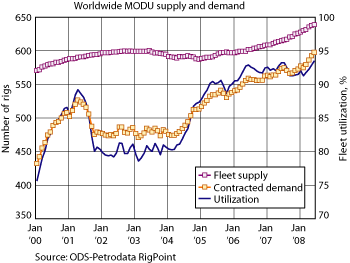 |
|
Fig. 1. The growth in worldwide offshore rig demand has been steadily rising since 2004.
|
|
Record day rates for offshore drilling units are being tallied. Rates in excess of $600,000 per day for high-specification, deepwater drilling units have been negotiated, and there is talk of still higher rates. To put the day rate increases in context, Table 2 compares average worldwide day rates for selected rig classes in January 2000 and June 2008.
| TABLE 2. Worldwide average MODU day rates-selected rig catergories |
 |
|
BILLIONS FOR NEW RIGS
Offshore rig market participants are betting that rig demand and day rates will continue to rise: As of July 1, 2008, rig owners and investors have 182 new Mobile Offshore Drilling Units (MODU) and six drilling tenders under construction or on order, Table 3. In addition, another eight rigs are planned, but not yet ordered, and more are expected. The total estimated cost of these rigs is more than $74 billion. Table 4 details the rigs under construction in US shipyards.
| TABLE 3. New MODU construction-July 2008 |
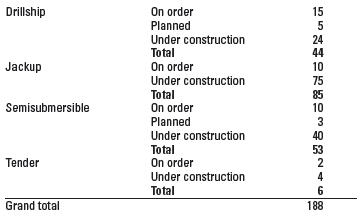 |
|
| TABLE 4. MODUs under construction in US shipyards |
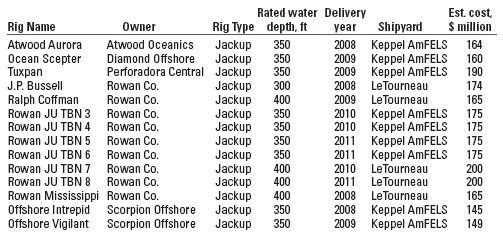 |
|
Most of these rigs will not be moving to the US Gulf or Canada to work. However, that does not mean players in the North American rig market cannot profit from the rise in global rig demand.
US GULF: MATURE, NOT DEAD
The current nature of the US GOM rig market can be seen in the companies contracting rigs. As of July 1, 2008, the company with the most rigs under contract and working was turnkey driller ADTI with 10 rigs. The next most active companies are Chevron (eight rigs), Apache (seven rigs), BP (seven rigs) and LLOG (five rigs). Two operators have four rigs working, three have three rigs, 15 operators have one rig each working and the remaining 13 operators have one rig each under contract and working.
The ADTI units are working for PetroQuest, Northstar Energy, Arena Energy, Apache, PetroQuest, Beryl Oil and Gas, W&T Offshore and Contango Oil and Gas.
Independent oil and gas companies continue to drive the US Gulf rig market, at least in terms of number of working rigs if not expenditures, and will continue to do so. However, the big boys still turn up regularly in the Gulf’s deep waters, although deep water is no longer the sole purview of major oil companies. At this writing, drillships are working for BP, Chevron, Anadarko and BHP Billiton. Semisubmersibles are working for the same four companies and for Devon Energy, Eni, ExxonMobil, Hess, LLOG, Marathon, Mariner Energy, Murphy, Noble Energy, Shell and Walter Oil & Gas.
With five rigs under contract, BP is the most active in the US Gulf’s deeper waters. Anadarko, BHP, Chevron and Shell each have three floaters working as of July 1, 2008, while ENI, Hess, LLOG and Noble Energy are operating two each.
In shallow water, 63 jackups and four submersibles are working for more than 30 different operators. The first half of 2008 has seen a turnaround in the US Gulf rig market as a whole, and given that the floating rig count has remained relatively stable at around 30 rigs, the improvement is in the shallow water market. Figure 2 shows US Gulf rig supply and demand, while illustrating the improvement in the contracted rig count and fleet utilization in recent months.
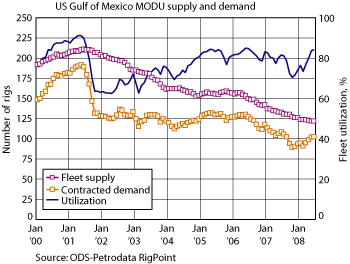 |
|
Fig. 2. In recent months, the US Gulf rig supply and demand contracted rig count and fleet utilization has improved.
|
|
With strong rig demand in international markets, competition for rig time, particularly deepwater rig time, has heated up day rates. Even the once-moribund US jackup market is seeing improved day rates.
As Fig. 3 shows, the recent increase in US Gulf jackup fleet utilization has given a boost to average day rates. ODS-Petrodata forecasts that jackup demand in the region will continue to rise, and day rates should go along for the ride.
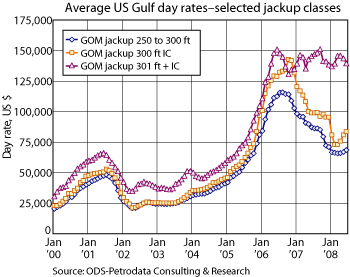 |
|
Fig. 3. Average day rates for GOM jackups and semis have increased due to strong rig demand and improved utilization.
|
|
Recent contracts for GOM independent-leg jackups rated for 300 ft and greater have ranged in day rate from $82,500 to $195,000, depending on the rig’s capabilities and specific contract requirements. Day rates for rigs rated to work in less than 300-ft waters have ranged from $58,500 to $90,000. While US Gulf jackup rates are lower than rates in the wider international market, many of the rigs remaining in the region are not readily able to work in other areas.
Day rates for floating rigs working in the region have leveled off in recent months, Fig. 4. But this is more a function of the tight supply situation than any significant change in the market. Most floating rigs are on long-term contracts, meaning there is little opportunity for day rates to move.
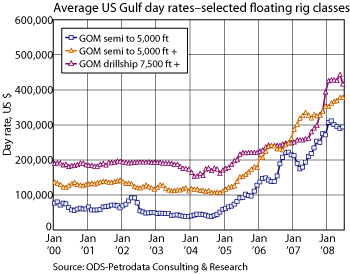 |
|
Fig. 4. Floater day rates have increased strongly since 2005.
|
|
Recent contract rates for semisubmersibles rated for less than 5,000-ft waters have ranged from $225,000 to $355,000. Semis rated for deeper water depths have been signed at rates ranging from $505,000 to more than $535,000 per day. Deepwater drillships, rated to work in water depths of 7,500 ft or greater, have seen recent contract rates ranging from $535,000 to $540,000 per day. However, one of the most recent contracts set a new record: Transocean will be paid $652,000 per day by Italy’s Eni for drillship Deepwater Pathfinder. The rig will go to work in the US Gulf in March 2010. The drillship is presently working for Shell off Nigeria.
ODS-Petrodata forecasts that US Gulf semi demand will increase by seven rigs by late 2009. Given the tight supply, not every operator with a semi requirement may be able to meet the anticipated time table. However, any semi shortage in the region is forecast to be short-lived.
Given that long-term planning has been necessary in the global drillship market for some time now, it comes as little surprise that demand for drillships in the US Gulf is expected to remain relatively flat into the second half of next year. However, some operators have indicated their intention to drill more aggressively in the deepwater US Gulf, and ODS-Petrodata forecasts that demand will exceed supply in the region’s drillship market in the second half of 2009. This means that some planned drilling campaigns will be delayed.
The tight deepwater rig supply situation is a hurdle for operators in all markets. ODS-Petrodata forecasts that, despite the fact that 42 new floating drilling units will be delivered by the world’s shipyards between now and the end of 2009, supply will fall short of meeting global demand for deepwater drilling units by an average of 20 rigs in 2009.
While some will argue that oil prices cannot be sustained at their current levels, the price of oil is unlikely to drop precipitously, and that allows operators intent on pursuing long-term deepwater projects to plan with some confidence. In addition, domestic natural gas prices, a key driver in the shallow water rig market, are almost double what they were 12 months ago.
At present, US Gulf operators have more than 50 drilling programs outstanding to which no rig is yet committed. All-in-all, the outlook for the US Gulf rig market is at least as positive as it has been for several years.
EXECUTIVE ORDER LIFTED
Over the longer term, the US offshore rig market may expand as a result of recent events in Washington. On July 14, President Bush lifted the executive order put in place by his father in 1990 that prohibited oil and gas exploration on most parts of the US Outer Continental Shelf. The move, a response to public pressure regarding high oil prices, is designed to pressure the US Congress to lift its own ban. The president has been calling on lawmakers to lift the ban for months.
While the president’s action clearly will not lead to any significant increase in offshore exploration and development for years (if ever), it does remove one hurdle to opening new areas to exploration that offshore operators faced. If federal impediments to offshore activity can be removed, leaving the individual states to determine on their own whether or not the benefits of offshore drilling outweigh the drawbacks, it appears likely that some states will welcome the offshore industry to their shores.
Virginia state officials have already sought changes in the congressional ban to allow natural gas drilling off their coast, but the effort was defeated in the Senate last year. The Minerals Management Service 2007-2012 five-year leasing plan has a provision for a Mid-Atlantic Planning Area lease sale should the various obstacles to such a sale be lifted.
CANADA: A PROMISE UNREALIZED
Strong rig demand in international markets has hurt drilling activity offshore Canada over the last few years, and now Canadian offshore operators are struggling to fill their rig requirements. The primary culprit is the small size of the Canadian Atlantic rig market. Since 2000, the most rigs the region could employ was five, and that was only consistently true back in 2003 when worldwide offshore rig fleet utilization was at or below 80%. With fleet utilization having been above 90% since late 2006, the Canadian offshore rig market just has not proven attractive for most rig owners.
At present, only two rigs are working offshore Canada; one of them just arrived in the area and started working at the end of June. Both are Transocean semisubmersibles, and both are working initially for Husky Oil Operations. One of the rigs, the Henry Goodrich, has work lined up with other operators as well.
Next year, a Rowan Co. Gorilla jackup is set to move into the area. The rig has a six-month commitment at present.
Seven Canadian operators have signaled their need for jackups and floaters for ten different drilling programs. Most are being realistic about their chances of landing rig time in the current market: None of the programs have estimated start dates before the second quarter of 2009, and half have estimated start dates in 2010 or beyond.
Unless and until Canadian operators are able to put together longer-term requirements, either singly or collectively, their rig needs may continue to go unmet. That said, recent license awards in Greenland may put new work on the table that, in combination with the outstanding Canadian requirements, could attract additional rig owner interest.
ALASKA: FEW TAKERS
Alaska is back on the offshore rig market radar screen, albeit in a small way, separately involving one major operator and two independents. Last year, whaling interests and others thwarted Shell’s plans to use the arctic rig Kulluk on a drilling program in the Beaufort Sea. The case remains in the courts, and as a result no drilling will take place in 2008. Shell has laid-off some workers as a result.
Shell may also employ a drillship in the area, although possibly not until 2010. Shell holds an option on Frontier Drilling’s Frontier Discoverer for work in Alaskan waters. The rig is presently in Southeast Asia.
California-based Pacific Energy, which has producing properties offshore California and Alaska, is planning a drilling program in Cook Inlet. Louisiana-based Blake Offshore landed the contract, and will mobilize its jackup Blake 151 from the US Gulf to Alaska. Timing of the mobilization has been adjusted, and at last report, the rig was expected to be on location and drilling in May 2009.
One other independent operator is known to have plans to drill in Cook Inlet. Texas-based Escopeta Oil had expected to begin drilling in the area in late 2006, but rig availability issues have kept the program on hold. The Blake 151 has been suggested as a possible substitute.
MEXICO: LATIN HOT
Without Mexico, the US Gulf jackup market would be severely overpopulated. As can be seen in Fig. 5, the ramp-up in Mexican offshore activity that began in 2002 peaked in 2004, but the region’s contracted rig count has only pulled back by a net five rigs since then.
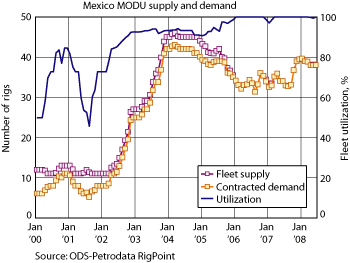 |
|
Fig. 5. Mexican offshore activity peaked in 2004 and is now below 80%.
|
|
Of the 38 rigs under contract to state operator Pemex, five are semisubmersibles and 33 are jackups. Three of the five semis and four of the 33 jackups are owned by US-based companies. And, while Pemex apparently has been a hard negotiator at times, rig owners generally have been pleased to have the work for rigs that otherwise might have stood idle.
The work has been fairly lucrative. Jackup day rates in Mexico have averaged above $135,000 all year, and 14 rigs are earning $150,000 or more per day. Semisubmersible rates are at levels similar to other markets, ranging in late June and early July 2008 from $190,000 to $484,000 per day.
Pemex is determined to find replacement reserves for the rapidly declining Cantarell Field, and while shallow water activity is the backbone of the operator’s present offshore activities, the push into deep water has begun. In 2010, Pemex will have at least five to seven semisubmersibles under contract and working, including three of the world’s newest, most modern units. Two of the three will be rated for 10,000-ft water depths, while the third will be rated at 7,500 ft.
The price of new technology is high, however. Pemex will pay in excess of $1.53 billion per day for the three rigs.
Pemex’s push to deep water may have a political price as well. Pemex and the current government acknowledge that the way to fast-track deepwater exploration and development is to bring in outside expertise. However, with ownership of natural resources vested in the people by the Mexican constitution, many Mexicans view such moves with suspicion. This sensitive issue is not likely to be resolved easily or soon, with the result that Pemex may not be able to reverse its declining production as rapidly as needed. This in turn could have its own repercussions, both economic and political. For now, Pemex continues to forge ahead. As of July 1, 2008, the state company had 20 outstanding, unfilled rig requirements, 13 for jackups and seven for platform rigs.
While the North American offshore rig market is no longer the world’s most lucrative for rig owners, neither is it about to wither away. Rig owners, positioned in the market with the right equipment, will be able to turn a profit on their activities in the region. Growth seems likely in Canada, Mexico and the deepwater US Gulf, and even the shallow water Gulf continues to show signs of life.
ODS-Petrodata’s latest rig market forecast for 2009 calls for a fairly well-balanced jackup market, albeit one with some older units remaining cold-stacked, and a small shortfall in floating rig supply versus demand. This scenario can play out across a wide range of potential oil and natural gas prices. 
|
THE AUTHOR
|
| |
Tom Marsh is Publisher and Vice President of Operations for ODS-Petrodata in Houston, Texas.
|
|
|











